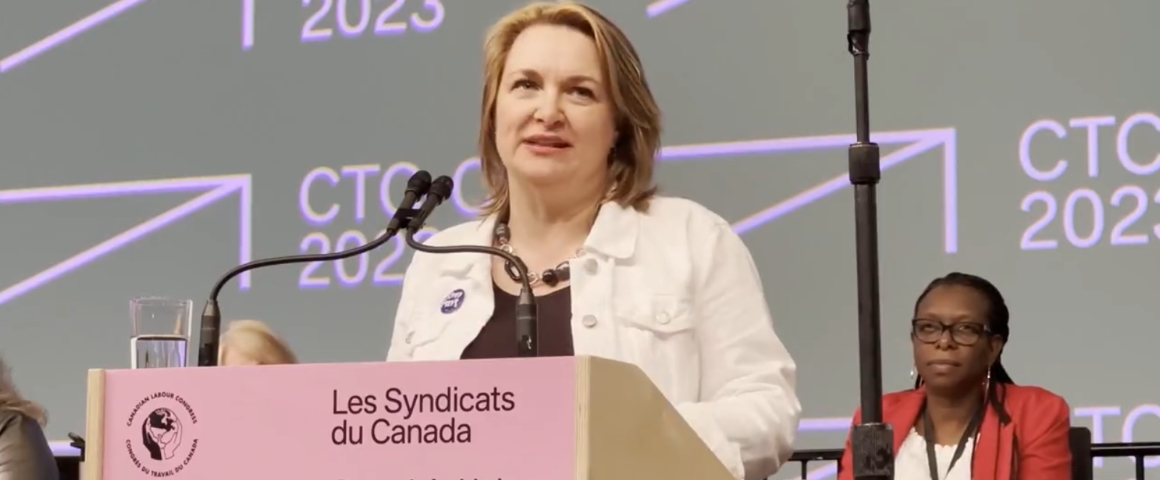By Adrien Welsh
May was an important month for the labour movement in Canada and Quebec. From May 8 to 12, some 2,500 delegates gathered in Montreal for the Canadian Labour Congress convention. The CLC is the country’s largest labour central, with which the Fédération des travailleurs et travailleuses du Québec (FTQ – Quebec Federation of Labour) is affiliated. A week later, the Confédération des syndicats nationaux (CSN – Confederation of National Trade Unions), which is not affiliated to the CLC, held its convention.
Despite a few differences in form, there were notable similarities between the two events, starting with a bias on the leaderships’ part to clearly favour social dialogue with management and government, instead of intensifying and energizing the working-class struggle.
On the CLC side, calls from the outgoing leadership to “kick ass for the working class” facilitated their re-election by the convention. Yet they also once again insisted, in vain, on trying to force through constitutional amendments that would have further centralized power in the hands of the largest affiliated unions. This point is not insignificant, since the 2021 election of Bea Bruske supposedly marked a break from the previous CLC leadership, which was known for eating out of the Liberal Party’s hand. It’s no coincidence that the plan of (in)action avoided calls for organizing, mobilizing and fighting, but spoke instead of “lobbying” and “demanding.”
As for the CSN, the outgoing president (who was re-elected along with the entire executive) reported without batting an eyelid that, thanks to the CSN, there is a “middle class” in Quebec.
At both conventions, the idea was to create the atmosphere of a corporate trade fair, far removed from militancy. The exhibition halls rolled out the red carpet for private insurance companies, while minimizing the participation of unions and other militant labour groups. The agendas were crafted around presentations, panels and hive discussions, purposely limiting the time available for debate among delegates on the floor. The only semblance of political action was a sloganistic treatment of societal issues and “green co-management.”
Workers’ militancy and determination is the basis for a strong movement
And yet, in the months leading up to these two gatherings, workers had demonstrated their militancy and determination. Labour disputes have multiplied and intensified, particularly around socio-economic issues, in a context of employers looking to make working people bear the burden of the COVID-related economic crisis. (Notably, neither convention included much analysis or critique of the government’s and employers’ management of the COVID crisis.)
Certainly, there was no shortage of delegates’ calls to intensify the struggle. But these were not concretely echoed in the resolutions and action plans. The main obstacle is not a lack of fighting spirit among workers, nor is it “bureaucratism” that some allege is inherent in the organized labour movement. It’s also incorrect and unhelpful to take a “rank-and-filist” approach which pretends that the real struggle is between labour’s grassroots and the leadership. (If this were true, we wouldn’t see an over-representation of union leaders over “ordinary” members at May Day rallies and other demonstrations.)
The real problem is one which transcends the question of leaders and grassroots activists: the real problem is the lack of mass labour political action that is independent of capitalist political parties, including social democratic ones. Yet both conventions rolled out the red carpet for political leaders – the NDP’s Jagmeet Singh at the CLC and Québec solidaire’s Françoise David at the CSN. In both cases, the goal is to erect a firewall between unions and politics, and to establish a form of subcontracting between the two.
But the organized working class cannot do without a mass political vehicle based on labour’s socio-economic demands. This key idea lies at the heart of the proposal for a federated party of labour.
Today, in the face of coordinated employer attacks which are encouraged by increasingly reactionary governments, the political question cannot be reduced to simple “opposition” to right-wing politicians. Such an approach amounts to waiting for the next election and subcontracting the political question to “friendly” political parties while seeking the best concessions through “social dialogue.”
Instead, the labour movement needs to stimulate class struggle and shift the balance of power in favour of the entire working class, not just unionized workers. Winning such a shift is not possible without the labour movement’s role as a catalyst, but nor is it possible without a series of political demands that reflect workers’ socio-economic condition.
“Leftist” anti-unionism serves the bosses
In this context, anti-unionism is not an option. This includes calls from sectarian and splinter groups for apathy towards unions because they are “too bourgeois,” or “bureaucratized,” or because they are “colonial structures.” Such appeals objectively serve the bosses, who are hoping for a disorganized, timid, trusting working class.
Workers need to strengthen and energize the labour movement, which includes debating key working-class issues – including political issues – in labour forums. The union movement is a fortress that working people built and organized – we must not allow it to be pulled down.
Get People’s Voice delivered to your door or inbox!
If you found this article useful, please consider subscribing to People’s Voice.
We are 100% reader-supported, with no corporate or government funding.




